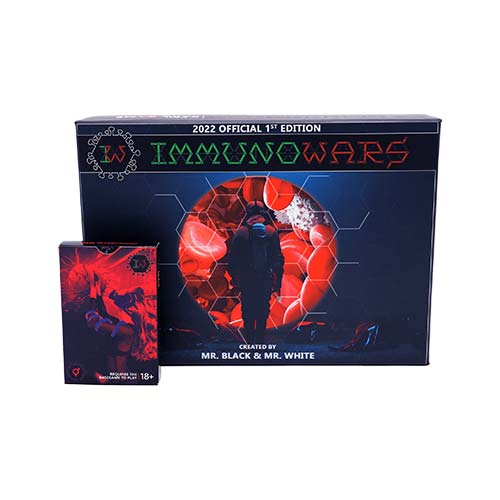Author: Liliana Sánchez Rocha
Read time: 6 minutes
It's been a week since you accidentally sliced your thumb while chopping vegetables for a delicious meal. Though your blood seemed to give an extra spiciness to your dish, the wound looks more disgusting every day that goes by. At first vivid red, now dark purple; your thumb keeps pulsating with a relentless throbbing pain. A few days later, your skin gives in, releasing a little river of thick, yellowish-green pus that drips slowly through your hand. Although nauseated at first, you can’t help but wonder: what on earth is this viscous cocktail? Well, that nasty pus is basically the graveyard of multiple germs, but also of your immune system’s kamikaze heroes. That’s right, your body’s first line of defense is composed of fearless warriors that do not hesitate to explode as a grenade to take down intruders. Among these immune superheroes are the Macrophages, armed with an insatiable ravenous appetite, but they are more than just hungry hunters, they are the special forces of your immune system. How do they defend you?

Macrophage’s role in immunity
Your body is guarded by the most fantastic army you could ever imagine. To protect their unique treasure (YOU) it is divided into two major forces that work in synchrony. The “frontline defenses” (innate immunity) are formed by everything that prevents or that can act right at the onset of any disturbance. While the “elite special forces” (acquired immunity) gather high commanders who go on continuous training to refine their tactics of war. Macrophages are cells that belong to the “frontline defenses”, trained with broad and basic knowledge to identify possible threats and equipped for immediate responses.
We are born with some of them already stationed all around our body, depending on the area of the body they inhabit, their protective abilities can slightly vary. Some others originate from immature “backpackers” called monocytes; these travel through the highway of the body (bloodstream) in search of their calling. When there is an emergency, they migrate to the hotspot and mature into macrophages, ending their days as young explorers to settle in this specific zone for the rest of their lives.
How do macrophages fight infections?
Macrophages are your body's ultimate multitaskers with never-ending responsibilities. It was believed that they were divided into two specialized units focused on immediate offensive (M1) or defensive (M2) roles. But recently it has been seen that macrophages have a great adaptability and depending on the challenge, they can make use of their wide set of skills independently of the unit they might belong to.
M1, the offensive units
But what do they specifically do? In general, the M1 units play a crucial role during germ invasion. For example; when the walls of your body get damaged (like after slicing your finger). The cells that have been wounded, together with those who witnessed the disaster, cry desperately for help through chemical SOS messages. Nearby macrophages, just minding their own business, encounter this trail of distress and spring into action. If the wound has been invaded by opportunistic germs, macrophages snap into their “beast mode”. A ferocious appetite stirs in their big, wobbly bodies and they charge straight towards the now terrified little germs. Just like a Marvel superhero, macrophages then stretch part of their bodies to create rubber-band arms that surround the invaders. The touch with the germs generates sparks that travel like electricity around their body and awake genetic memories. The macrophage now knows what type of enemy is facing and holds strongly to it. In a deadly cuddle, the bugs are forcibly squeezed into the macrophage’s gut where they will be fused to their hidden weapon: the “bubble of death”, a chamber filled with destructive chemicals. Even in their gut, the macrophages keep scanning their meal to decide the next move. They can call for immediate backup (neutrophils) But if the invasion gets out of control, they also release other SOS messages to call in the highly trained commanders (T cells), great strategists who specialize in coordinating direct attacks.
Once on the battlefield, macrophages inform T cells about the suspects by presenting the remains of the digested bodies. This information, combined with all the screams for help (distress signs), activates and infuriates the T cells commanders. While the elite forces coordinate and prepare the deliberate ambush, macrophages can continue feasting to death. Yes! M1 forces can engage in pretty impressive battles! like that to contain tuberculosis. where they not only team up with other cells, but literally they fuse their bodies around the intruders to corner them in the middle of this “living fortress”. This is the force of your immune system: dynamic and courageous. But, besides fighting with outsiders, the M1 unit also has to eliminate other dangerous criminals: one of your own! Any of your cells that rebel against your organism’s rules MUST be destroyed since insurrection leads to cancer. This contention is also a team effort and the M1 forces play an important part in this.
M2, the defensive units
On the other hand, the M2 unit is the medics and recovery team. They use their never-ending hungriness to eat and clear away dead cells and other organic wastes left after any emergency. And just like cities need to be rebuilt after an attack, M2 helps in the reconstruction and the healing process of the damaged zone. On top of this, these macrophages safeguard the peace and balance of your body. Much in the same way as the M1 units carry the power to infuriate the T-cell commandos, which starts a targeted attack, M2 can do exactly the opposite. They present digested components that are safe and should be tolerated by your body, like the food you eat! M1 and M2 forces work together to balance peace and war.
Are macrophages always heroes?
The multifaceted roles and heroic traits of macrophages make them the special forces of the body's immune system. As you now know, these little cells have huge responsibilities in keeping you healthy and alive. But what happens if they lose their appetite? Or their chamber of death doesn't work as promised, letting germs escape? If they cannot reconstruct the damage after a fight? Or what if an uprising begins among them and they use their power against you? In that case, your heroes might become one of the worst enemies you could ever encounter... But that is a story for Mr. black and his dark forces to tell.
Now, every time you leave a wound unattended until it starts oozing thick yellowish pus, you will know that there was a ferocious battle to contain a nasty invasion. Wash your wounds next time!!
Gameplay Guide: Defend with Macrophages in ImmunoWars
lo and behold! Macrophages have come to save you from bad decisions, or perhaps from bad condoms! This card is available in the ImmunoWars STD booster pack, so you can protect yourself against any nasty STDs caused by any bacteria!
This Immunocards is play in two actions: First: add it to your immune army and place it next to your equipped cards. Second: select one of its abilities and pay for it! You have two options, choose your weapon wisely! For 6 ATP unleash the force of the “Chamber of death” and annihilate a 2-star bacteria with an acidic shower. This macrophage never says no to seconds! so keep it among your army. But wait! Perhaps you got a serious STD this time, fear not! For 4 ATP your macrophage will make use of all its inner power to destroy a 3-star bacteria and everything around it! You will win this battle but beware of the collateral damage -- It will cost you 2 Health points (HP)... the price of victory! (maniacal laughter). You will never defeat gonorrhea as easy as in this battlefield! What are you waiting for? Get ImmunoWars here.
References:
- Wang LX, Zhang SX, Wu HJ, Rong XL, Guo J. M2b macrophage polarization and its roles in diseases. J Leukoc Biol. 2019 Aug;106(2):345-358. doi: 10.1002/JLB.3RU1018-378RR. Epub 2018 Dec 21. PMID: 30576000; PMCID: PMC7379745.
- Kadomoto S, Izumi K, Mizokami A. Macrophage Polarity and Disease Control. Int J Mol Sci. 2021 Dec 23;23(1):144. doi: 10.3390/ijms23010144. PMID: 35008577; PMCID: PMC8745226.
- Wang C, Ma C, Gong L, Guo Y, Fu K, Zhang Y, Zhou H, Li Y. Macrophage Polarization and Its Role in Liver Disease. Front Immunol. 2021 Dec 14;12:803037. doi: 10.3389/fimmu.2021.803037. PMID: 34970275; PMCID: PMC8712501.
- Locati M, Curtale G, Mantovani A. Diversity, Mechanisms, and Significance of Macrophage Plasticity. Annu Rev Pathol. 2020 Jan 24;15:123-147. doi: 10.1146/annurev-pathmechdis-012418-012718. Epub 2019 Sep 17. PMID: 31530089; PMCID: PMC7176483.
- Yumiko Oishi, Ichiro Manabe, Macrophages in inflammation, repair and regeneration, International Immunology, Volume 30, Issue 11, November 2018, Pages 511–528,
- Lazarov T, Juarez-Carreño S, Cox N, Geissmann F. Physiology and diseases of tissue-resident macrophages. Nature. 2023 Jun;618(7966):698-707. doi: 10.1038/s41586-023-06002-x. Epub 2023 PMID: 37344646; PMCID: PMC10649266.
- Justiz Vaillant AA, Sabir S, Jan A. Physiology, Immune Response. 2022 Sep 26. In: StatPearls [Internet]. Treasure Island (FL): StatPearls Publishing; 2024 Jan–. PMID: 30969623.



